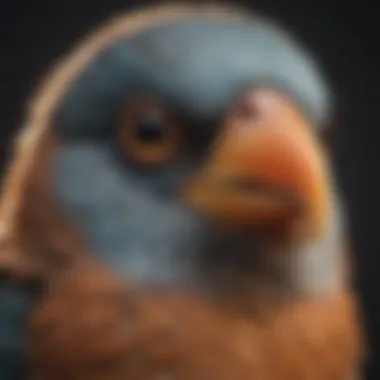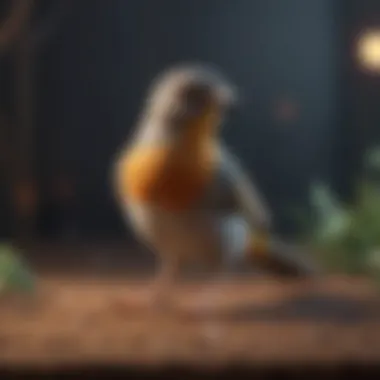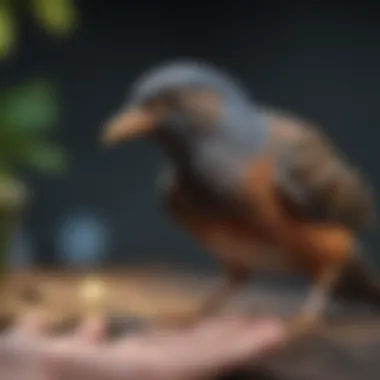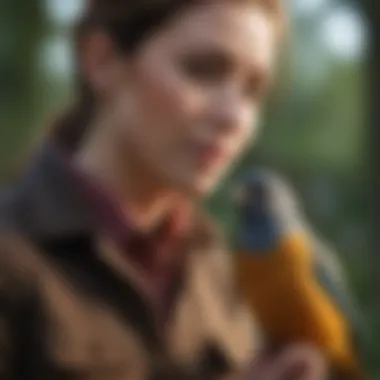Where Not to Pet Your Bird: Essential Interaction Tips


Intro
Interacting with pet birds requires knowledge of their behavior and comfort zones. This guide provides essential information on where not to pet your bird and why these boundaries matter. By understanding avian anatomy and responses to touch, bird owners can improve their relationship with their feathered companions. Recognizing discomfort can lead to better care practices and enhanced quality of life for pet birds.
Care Tips
Maintaining a happy and healthy bird extends beyond diet and cage setup. Regular routines create a sense of security and establish trust. Here are key aspects of daily care:
Daily Care Routines
Birds thrive on consistency. Establish daily schedules for feeding, playtime, and maintenance of social interaction. Record behavior changes that idicate possible stress.
Cage Setup and Maintenance
The cage must replicate their natural habitat as closely as possible. Enhance it with various perches, toys, and places for them to hide. Regular cleaning ensures a healthy environment.
Hygiene and Cleaning Practices
Clean the cage multiple times a week to prevent bacterial growth. The food and water containers should be washed regularly. Use bird-safe cleaning supplies.
Seasonal Care Adjustments
Birds can be sensitive to seasonal changes. During colder months, ensure they have a suitable heat source. In warmer months, provide ample ventilation. Regularly monitor their activity levels to detect any discomfort.
Behavioral Insights
Understanding avian body language is crucial for successful interaction with pet birds.
Understanding Bird Body Language
Birds communicate a range of feelings through body language. Fluffed feathers or an exposed breast can signal distress. Take note of their posture before approaching them.
Common Behavioral Issues and Solutions
Aggression and fear of handling are common issues for pet birds. Gradual desensitization and positive reinforcement can help.
Positive Reinforcement Techniques
Rewarding desired behaviors fosters a positive atmosphere. Use small treats to encourage a relaxed and friendly attitude during interactions.
Social Interaction Needs
Birds are social creatures. Regular interaction with you or other birds enhances their well-being. Prolonged isolation may lead to depression or other health issues.
Nutrition Guides
Nutrition plays a critical role in a bird’s well-being. Providing a balanced diet helps them lead a healthy life.
Essential Diet Components
Grains, seeds, fruits, and vegetables should populate their diet. Customize menus according to their species needs.
Safe and Toxic Foods
Be aware of toxic foods, such as chocolate and onions, which can pose serious health risks. Consult a detailed list from reputable sources.
Supplements and Treats
Occasional treats can help bond with your bird. Conversely, retain reptile-safe vitamins to complement their main diet.
Feeding Strategies for Different Species
Tailor feeding habits to the unique diets of different species. Research proper feeding strategies to ensure their nutritional needs are met.
Wellness and Health


Bird health goes beyond diet and surroundings. Weakness can arise from unbananale attempts at interaction.
Routine Health Checkups
Conduct routine vet visits. Regular health checkups aid in early detection of illnesses.
Identifying Symptoms of Illness
Keep a lookout for changes in appetite or behavior. Consult a vet immediately if you notice signs of distress.
Preventative Care and Vaccinations
Vaccinations are crucial for preventing illnesses. A comprehensive vaccination schedule should be strictly followed.
Mental and Emotional Well-being
Mental health is as vital as physical health. Provide toys and appropriate challenges to prevent boredom.
Enriching Activities
Birds require mental stimulation and physical activity monthly.
Toys and Playtime Ideas
Create a diverse array of toys timer. They can help provide necessary entertainment. Make sure to rotate the toys to stimulate interest.
Training and Tricks
Engaging birds in simple tricks can be very rewarding. This not only enhances your bond but also keeps them mentally fit.
Outdoor Activities and Interaction
If possible, supervise outdoor time. A secure playpen works sufficiently to prevent escape or prey attacks.
DIY Projects for Mental Stimulation
Creating DIY toys can be economical and fun. Simple items can provide hours of enrichment. Engage yourself in crafting bird-approved objects.
Understanding where to not pet one's bird helps significantly enhance the human-bird connection.
Foreword
Interacting with birds necessitates a nuanced understanding of their anatomy, behavior, and emotional well-being. Pet birds can exhibit a range of reactions to handling, making it essential for owners to establish appropriate boundaries. Understanding these parameters not only fosters the well-being of avian pets, but also enhances the bond between the owner and their feathered friend.
There are several factors that make this knowledge crucial. First, birds are instinctively vulnerable creatures. Knowing their sensitive areas empowers you to avoid interactions that may induce stress or discomfort.
Second, understanding a bird's body language can help you discern when and how to approach petting. This preparation can significantly reduce the chances of misunderstandings that may harm your relationship with your pet.
Finally, recognizing what not to pet aids in the prevention of injuries or bouts of aggression. Birds, although often domesticated, retain many instincts harmful to themselves when they feel cornered or threatened. By respecting their boundaries in both physical and emotional interactions, you cultivate an atmosphere that promotes trust and security.
In summary, this section provides a foundation. It informs bird owners of the vital aesthetics of avian mechanics, paves the way for building lasting relationships, and guarantees that the interaction remains pleasant for both parties. From understanding anatomy to recognizing signs of unease, this robust introduction sets the stage for the guidelines outlined in the sections that follow.
Understanding Bird Anatomy
Understanding bird anatomy is essential when interacting with avian pets. Their physical structure influences their behavior and reactions. Recognizing the implications tied to their form can lead to healthier and more enjoyable interactions.
Avian anatomy is distinct from that of mammals. For instance, birds possess feathers instead of hair. Feathers serve numerous functions including warmth, moisture protection, and of course, flight. Beneath these feathers lies sensitive skin. This skin can react adversely to touch or pressure, emphasizing how critical it is to know where a bird can and cannot be handled.
Understanding anatomical boundaries enhances the bond between humans and birds. By respecting their comfort zones, bird owners cultivate trust and reduce stress for their pets. Additionally, knowledge of anatomy can alert owners to potential health issues. Sometimes signs can be subtle, and a keen eye for anatomical abnormalities can lead to timely intervention.
Feathers and Skin Sensitivity
Feathers play a vital role in the life of a bird, not simply for aesthetics. Each feather acts as a protective layer, covering sensitive skin beneath. This skin has a rich nerve supply, which makes it highly sensitive to touch
When patting a bird, the location is crucial. Feather comfort levels vary. For example, birds can typically tolerate gentle strokes along their bodies, but the skin on their face or under the wings is often more sensitive. Understanding this can help prevent unwanted stress during interactions.


Moreover, irritation or damage due to incorrect handling can lead to behavioral changes. Stress-induced behaviors might revolve around aggression or fear, which are indicators that boundaries have been crossed. Therefore, having knowledge about feathers and skin sensativity can enhance the overall training and bonding experiences.
Sensitive Areas: An Overview
Some areas on a bird’s body, while possibly appealing to touch, might trigger stress or fear. While birds are more tolerant of touch in certain regions, there are distinct areas that generally should be avoided.
- Head Area: Many birds perceive touches on their heads as a potential threat. In many species, a strike to the head might be viewed as a worse danger. Therefore, even gentle stroking can spawn unwanted defensive behavior.
- Belly: A bird's belly is vulnerable. They associate touches here with being preyed on. It is advisable to prevent interactions in this area unless the pet is fully calm and used to such contact.
- Underwings: Like the belly, this region is highly sensitive. Birds usually feel defenseless here, and overstimulation could provoke extreme reactions.
- Tail and Feet: These areas are also sensitive. Touching a bird’s tail could interrupt their balance or the poise of their stance.
Recognizing sensitive areas aids in creating a trusting relationship with a bird. Thus, this knowledge fosters comfortable interactions — paving the way for enjoyable pet ownership.
Common Mistakes in Bird Petting
When you have a bird as a pet, understanding how to interact with it is crucial. Many bird owners often make mistakes that can cause discomfort or stress for the bird. Recognizing these common mistakes in bird petting can lead to a better relationship with your feathered friend and contribute to their overall well-being. The aim here is to improve the quality of interaction between you and your pet while respecting their boundaries.
Ignoring Body Language
Body language in birds is a key communication tool that pet owners should never underestimate. Birds express their feelings through various gestures or postures. Signs of distress, fear, or comfort can be seen in the positions of their feathers, heads, and even tails. When a bird fluffs its feathers, it might be feeling insecure. Alternatively, a bird that is comfortable often keeps its feathers smooth and calm.
Here are some behaviors to observe:
- Tail Feathers: A tightly held tail may indicate tension, while a slightly spread tail can signal relaxation.
- Head Position: A bird leaning forward can be inviting interaction, but if it pulls back, this may mean it desires personal space.
- Beak Movements: A beak that moves in a rapid manner could indicate agitation or distress. Paying attention to such signals ensures you do not overlook a bird’s comfort level.
“Recognizing your bird's signs of discomfort is the first step towards growing a deeper trust.”
Failing to recognize these subtle signs may lead to knowing adversity in your attempts to have meaningful interactions. Not taking hints like these seriously can result in prolonged discomfort for the bird, thus damaging the connection and trust you have built over time.
Overstimulation and Its Effects
Similar to humans, birds can experience overstimulation during petting. While many pet owners want to bond with their birds, excessive handling can backfire. Birds often prefer shorter, controlled interactions rather than prolonged petting sessions. This misunderstanding can lead to increased stress and anxiety, potentially resulting in behavioral issues.
Some effects of overstimulation to keep in mind include:
- Aggressive Behavior: Birds may resort to biting or lunging as a means of protecting themselves if they feel overwhelmed.
- Withdrawal: A highly stimulated bird may start distancing itself from interactive purposes.
- Vocal Changes: Increased vocalization, particularly screams or loud chirps, can signal displeasure or annoyance as well.
Minimizing the risk of overstimulation involves understanding your bird's tolerance limits and respecting the boundaries set forth. Keeping an eye on their reactions during handling routines allows you to adjust your pets according to their emotional state.
In summary, recognizing body language and avoiding overstimulation are vital practices for pet bird interaction. Avoiding these mistakes contributes to stress-free environments that cultivate a healthy human-bird relationship.
Areas to Avoid When Petting
Understanding where to avoid petting is essential for creating a safe and nurturing environment for birds. Each species exhibits unique preferences and sensitivities that pet owners must respect. Avoiding certain areas can greatly reduce stress for the bird. This section explores crucial zones where petting can lead to discomfort or even aggressive behavior.
Head Area: A Critical Zone
Understanding Defense Mechanisms
Birds have specific defense mechanisms in place that dictate how they respond to potential threats. The head, particularly feather placements, is critical in signaling discomfort or aggression. The key characteristic here is the vulnerability aspects. The head contains many nerve endings, which make it quite sensitive. Moreover, this is where a bird perceives initial threats. For owners, recognizing these characteristics can be invaluable. Understanding these defense mechanisms leads to a more respectful interaction.
Why Some Birds Dislike Head Petting
Certain birds simply find head petting unpleasant. This aversion may arise from feelings of danger or a challenge to their territory. Birds may stretch or tilt their heads during interactions, which indicates stress. It's crucial for pet owners to note this behavior. The key factor in understanding this dislike is territory perception. Many birds feel their heads need to be protected. In learning about this stage of interaction, the bird caretakers can adjust their approach to what is appropriate.
Belly and Under Wings: Areas of Distress
The Role of Belly Vulnerability
The belly area can be particularly vulnerable. Birds protect this area instinctively, due to their sensitivity here. If approached too aggressively, it could induce fear in the bird. This vulnerability is crucial as it can initiate defensive actions. Recognizing this contributes to safer interactions and enhances the trust between bird and owner. It's here that education becomes essential for understanding appropriate petting zones.
What Underwing Petting Indicates
Petting under the wings often gives a false sense of affection. In reality, it's an area that can provoke a squirmish response. Many birds receive strong sensations in these locations, which can result in distress signals. Key signs to look for are body twists or vocal protests. Understanding what this part of the body represents encourages more careful interaction decisions with birds.
Tail: Signs of Discomfort
Birds may become agitated with tail touches or movements. Much like a cat, they may perceive tail interactions as violations of their personal space. It often leads to vocal actions aimed at dissuading continued contact. This signals a lack of comfort in this particular area and should be observed by owners.


Feet: A Risky Area
Assessing Comfort Levels
Birds generally view their feet differently than humans. They rely on their feet for stability and navigation. Assessing comfort here becomes vital. Identify body language cues like shifting or raising the foot. Recognizing these signals facilitates better awareness and care. Proper attention highlights the importance of foot interactions with less risk involved.
Reactions to Foot Touching
Similar to tail interactions, touching birds feet can provoke strong reactions. Some may exhibit quick retreat actions or high-pitched vocalizations. This indicates immediate discomfort. Touching for short intervals can help determine common responses as well. Observing the outcomes of light touches can educate and reassure bird owners about reacting to bird behavior.
Recognizing Signs of Discomfort
Recognizing signs of discomfort in birds is crucial for any bird owner or enthusiast. A bird that feels uncomfortable or stressed is not only at risk for behavioral issues but also for physical health problems. Understanding how to interpret bird vocalizations, body posture, and other physical indicators can significantly enhance the owner-bird relationship. Being attuned to these signals means the bird can be handled more appropriately, which leads to a reduced chance of negative outcomes.
Vocalizations: Meaning and Context
Vocalizations serve as a primary means of communication for birds. They can express a range of feelings, from contentment to distress. Common sounds include chirps, squawks, and whistles.
- Chirping: Often indicates a relaxed state. It’s a sound associated with comfort.
- Squawking: This can signify distress or discomfort, especially if loud and persistent.
- Hissing or Growling: These sounds typically indicate a strong negative response. Witnessing these vocalizations means it is time to give the bird space.
Observing in what context these sounds are made is essential. If a bird vocalizes while being touched in a specific area, it might be revealing discomfort. Recognizing the context allows us to adjust our behavior accordingly.
Body Posture: What to Look For
Birds communicate a lot through their body language. Observing body posture is important in assessing how a bird is feeling.
- Puffed up feathers: Indicates the bird may feel threatened or unwell.
- Crouching or hiding: Can point toward fear or anxiety.
- Standing on tiptoe: May signal discomfort or excitement, depending on the other behaviors accompanying it.
Daily interaction provides valuable experience in understanding individual bird behavior. Each bird has unique characteristics, which means owners should take the timme to learn specific signals related to their bird.
Wing Flapping: Implications
Wing flapping, while a natural behavior, can mean different things depending on the context.
- Excited wing flapping: Indicates enjoyment or anticipation, commonly when a bird sees a favorite food.
- Frantic flapping: Often represents agitation or need for escape. This is a significant signal of discomfort.
Recognizing the difference between these meanings is critical. For example, if a bird is flapping wildly while being interacted with, it can be a strong indication that they would prefer to be left alone. Addressing such concerns leads to a more peaceful and respected interaction.
Establishing Positive Interaction Practices
Establishing positive interaction practices is crucial for the wellbeing of pet birds. Birds have distinct needs and sensitivities that require careful consideration. By fostering a supportive environment, owners can build trust, making the interaction both enjoyable and safe for the bird. There are specific elements to consider, such as how to gradually introduce touch and use positive reinforcement through treats. These elements not only help reduce anxiety but also strengthen the bond between the owner and the bird.
Understanding these practices enhances the owner's ability to respond to their bird's behavior thoughtfully. When bird owners prioritize positive interactions, they minimize stress and create a safer space for avian companionship.
Gradual Preamble to Touch
When it comes to petting birds, a gradual approach is essential. Sudden movements can startle them and may trigger avoidance behavior. To properly introduce touch, begin by observing the bird's comfort zone. Notice where it feels relaxed and which areas it tends to avoid. Slowly reach out a hand, allowing the bird to initiate contact. Consistency is key here; by allowing the bird to dictate the pace, trust is built over time.
A few strategies to keep in mind include:
- Use a Calm Voice: Speaking softly while extending a hand can help keep the bird relaxed.
- Persistent Patience: Some birds may take longer to feel comfortable. Repeat the process without rushing.
- Reinforce Positive Behavior: Reward the bird for any step forward in interaction, no matter how small. This reinforces its confidence.
Using Treats to Encourage Bonding
Treats can serve as powerful tools in fostering positive connections with birds. Offering a treat encourages the bird to engage and can help solidify a sense of security. Select healthy treats that the bird enjoys, as this can motivate it to be more open to interaction.
When using treats, consider these tips:
- Introduce Treats Gradually: Start by presenting the treat in an open hand. Allow the bird to approach at its own pace.
- Combine with Positive Experiences: Pair the treat with gentle verbiage and calm movements. Create associations with positive outcomes.
- Avoid Overdoing It: While treats are useful, moderation is vital. Too many can lead to spoilage and can detract from the effectiveness.
Treats viewed as an extension of affection can create trust and enhance the relationship between bird and owner.
Effective bonding practices can transform an owner's experience. Birds that feel secure are less likely to manifest distress signals and are more willing to interact, leading to a more harmonious relationship between the bird and its owner.
Epilogue
Understanding where and how to pet birds is crucial in the care of these unique companions. This article emphasizes specific zones to avoid to prevent discomfort or even aggression in avian interactions. The head region, along with the belly and under wings, requires special consideration due to the inherent sensitivities in these areas.
Birds communicate discomfort through various vocalizations and body language. Recognizing these signs strengthens the bond between owner and pet. Being observant means you can adjust your behavior, addressing the bird's needs effectively. Using understanding as a foundation for interaction leads to a more positive experience.
Additionally, establishing proper practices for petting helps mitigate any potential stress. With gradual introductions and reinforcement through treats, one can create safe havens for interactions, fostering trust and companionship.













